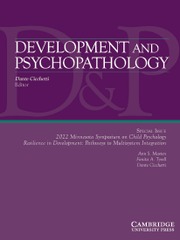Crossref Citations
This article has been cited by the following publications. This list is generated based on data provided by
Crossref.
Ponson, Laura
and
Bonnet-Brilhault, Frédérique
2001.
Autisme et psychomotricité.
p.
39.
Boyd, Brian A.
McBee, Matthew
Holtzclaw, Tia
Baranek, Grace T.
and
Bodfish, James W.
2009.
Relationships among repetitive behaviors, sensory features, and executive functions in high functioning autism.
Research in Autism Spectrum Disorders,
Vol. 3,
Issue. 4,
p.
959.
Valeri, Giovanni
and
Speranza, Mario
2009.
Modèles neuropsychologiques dans l'autisme et les troubles envahissants du développement.
Développements,
Vol. n° 1,
Issue. 1,
p.
34.
Castellani, M.L.
Conti, C.M.
Kempuraj, D.J.
Salini, V.
Vecchiet, J.
Tetè, S.
Ciampoli, C.
Conti, F.
Cerulli, G.
Caraffa, A.
Antinolfi, P.
Galzio, R.
Shaik, Y.
Theoharides, T.C.
De Amicis, D.
Perrella, A.
Cuccurullo, C.
Boscolo, P.
Felaco, M.
Doyle, R.
Verrocchio, C.
and
Fulcheri, M.
2009.
Autism and Immunity: Revisited Study.
International Journal of Immunopathology and Pharmacology,
Vol. 22,
Issue. 1,
p.
15.
Lewis, Mark
and
Kim, Soo-Jeong
2009.
The pathophysiology of restricted repetitive behavior.
Journal of Neurodevelopmental Disorders,
Vol. 1,
Issue. 2,
p.
114.
Hughes, John R.
2009.
Update on autism: A review of 1300 reports published in 2008.
Epilepsy & Behavior,
Vol. 16,
Issue. 4,
p.
569.
Asp, Linnéa
Beraki, Simret
Kristensson, Krister
Ögren, Sven Ove
and
Karlsson, Håkan
2009.
Neonatal infection with neurotropic influenza A virus affects working memory and expression of type III Nrg1 in adult mice.
Brain, Behavior, and Immunity,
Vol. 23,
Issue. 6,
p.
733.
South, Mikle
Larson, Michael J.
Krauskopf, Erin
and
Clawson, Ann
2010.
Error processing in high-functioning Autism Spectrum Disorders.
Biological Psychology,
Vol. 85,
Issue. 2,
p.
242.
Archer, Trevor
Kostrzewa, Richard M.
Beninger, Richard J.
and
Palomo, Tomas
2010.
Staging Perspectives in Neurodevelopmental Aspects of Neuropsychiatry: Agents, Phases and Ages at Expression.
Neurotoxicity Research,
Vol. 18,
Issue. 3-4,
p.
287.
Shneider, Yevgenia
Shtrauss, Yael
Yadid, Gal
and
Pinhasov, Albert
2010.
Differential expression of PACAP receptors in postnatal rat brain.
Neuropeptides,
Vol. 44,
Issue. 6,
p.
509.
Zelazo, Philip David
and
Müller, Ulrich
2010.
The Wiley‐Blackwell Handbook of Childhood Cognitive Development.
p.
574.
Messer, Anne
2010.
Mini-review: Polybrominated diphenyl ether (PBDE) flame retardants as potential autism risk factors.
Physiology & Behavior,
Vol. 100,
Issue. 3,
p.
245.
Baune, Bernhard T.
Konrad, Carsten
Suslow, Thomas
Domschke, Katharina
Birosova, Eva
Sehlmeyer, Christina
and
Beste, Christian
2010.
The Reelin (RELN) gene is associated with executive function in healthy individuals.
Neurobiology of Learning and Memory,
Vol. 94,
Issue. 4,
p.
446.
Holmboe, Karla
Elsabbagh, Mayada
Volein, Agnes
Tucker, Leslie A.
Baron-Cohen, Simon
Bolton, Patrick
Charman, Tony
and
Johnson, Mark H.
2010.
Frontal cortex functioning in the infant broader autism phenotype.
Infant Behavior and Development,
Vol. 33,
Issue. 4,
p.
482.
2010.
Current World Literature.
Current Opinion in Neurology,
Vol. 23,
Issue. 2,
p.
194.
LeJeune, Brenna
Beebe, Dean
Noll, Jennie
Kenealy, Laura
Isquith, Peter
and
Gioia, Gerard
2010.
Psychometric Support for an Abbreviated Version of the Behavior Rating Inventory of Executive Function (BRIEF) Parent Form.
Child Neuropsychology,
Vol. 16,
Issue. 2,
p.
182.
Gargaro, Belinda A.
Rinehart, Nicole J.
Bradshaw, John L.
Tonge, Bruce J.
and
Sheppard, Dianne M.
2011.
Autism and ADHD: How far have we come in the comorbidity debate?.
Neuroscience & Biobehavioral Reviews,
Vol. 35,
Issue. 5,
p.
1081.
Alderson‐Day, Ben
2011.
Verbal problem‐solving in autism spectrum disorders: A problem of plan construction?.
Autism Research,
Vol. 4,
Issue. 6,
p.
401.
Khursheed, Faraz
Tandon, Nitin
Tertel, Kathrin
Pieters, Thomas A.
Disano, Michael A.
and
Ellmore, Timothy M.
2011.
Frequency-specific electrocorticographic correlates of working memory delay period fMRI activity.
NeuroImage,
Vol. 56,
Issue. 3,
p.
1773.
Hughes, Claire
2011.
Changes and challenges in 20 years of research into the development of executive functions.
Infant and Child Development,
Vol. 20,
Issue. 3,
p.
251.

